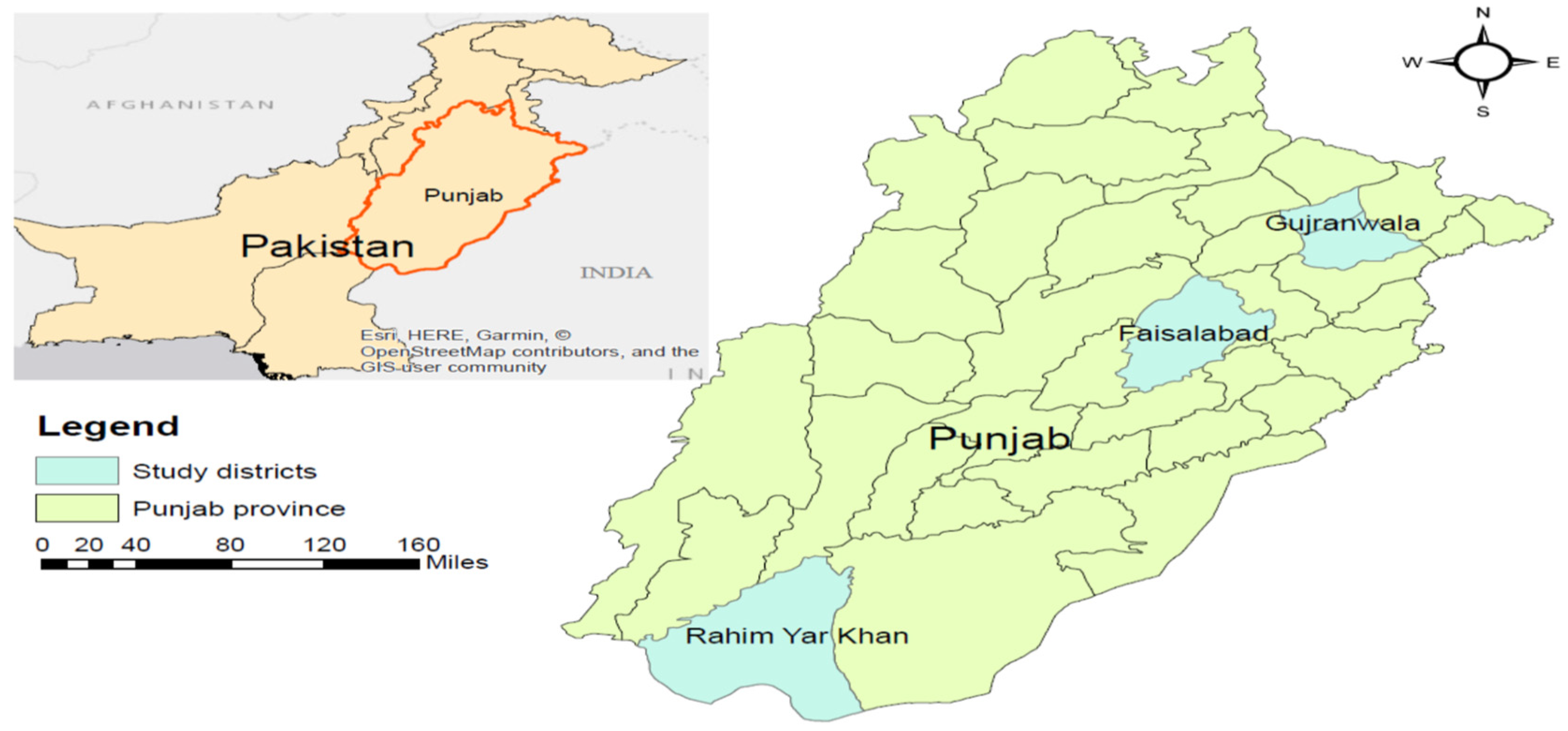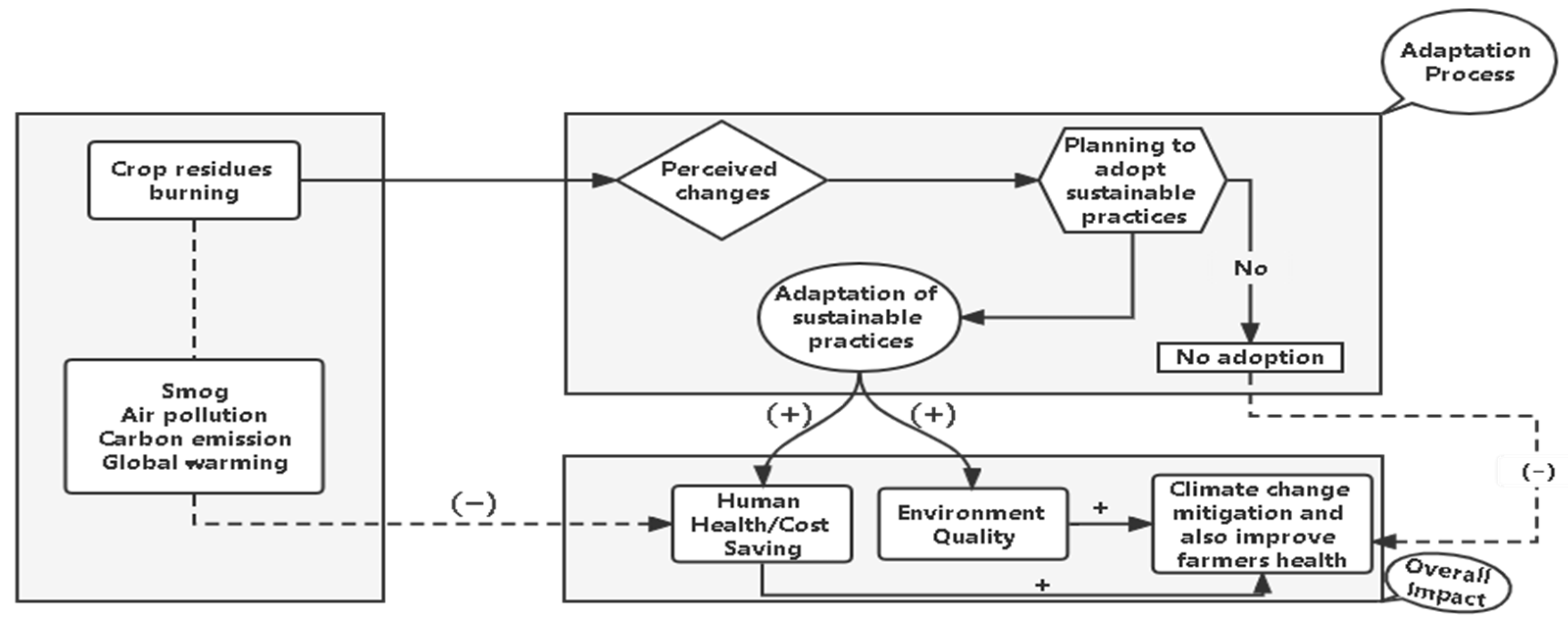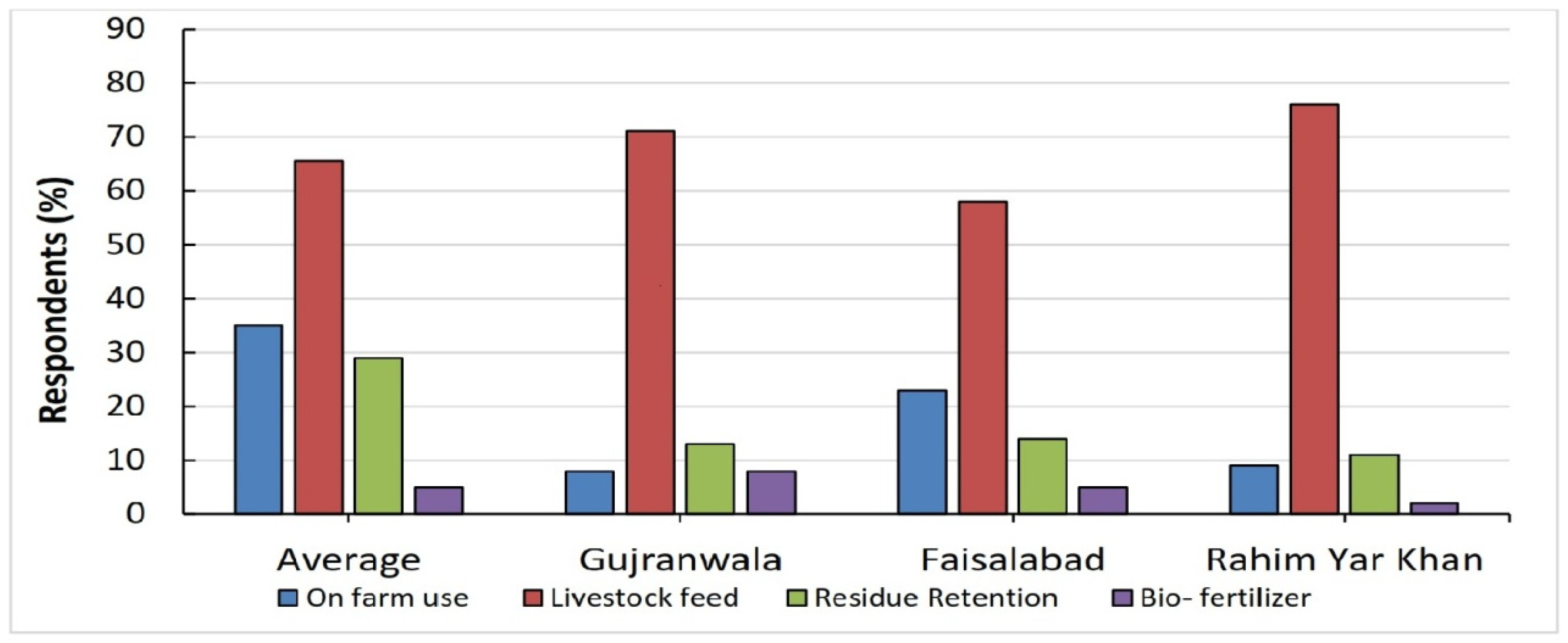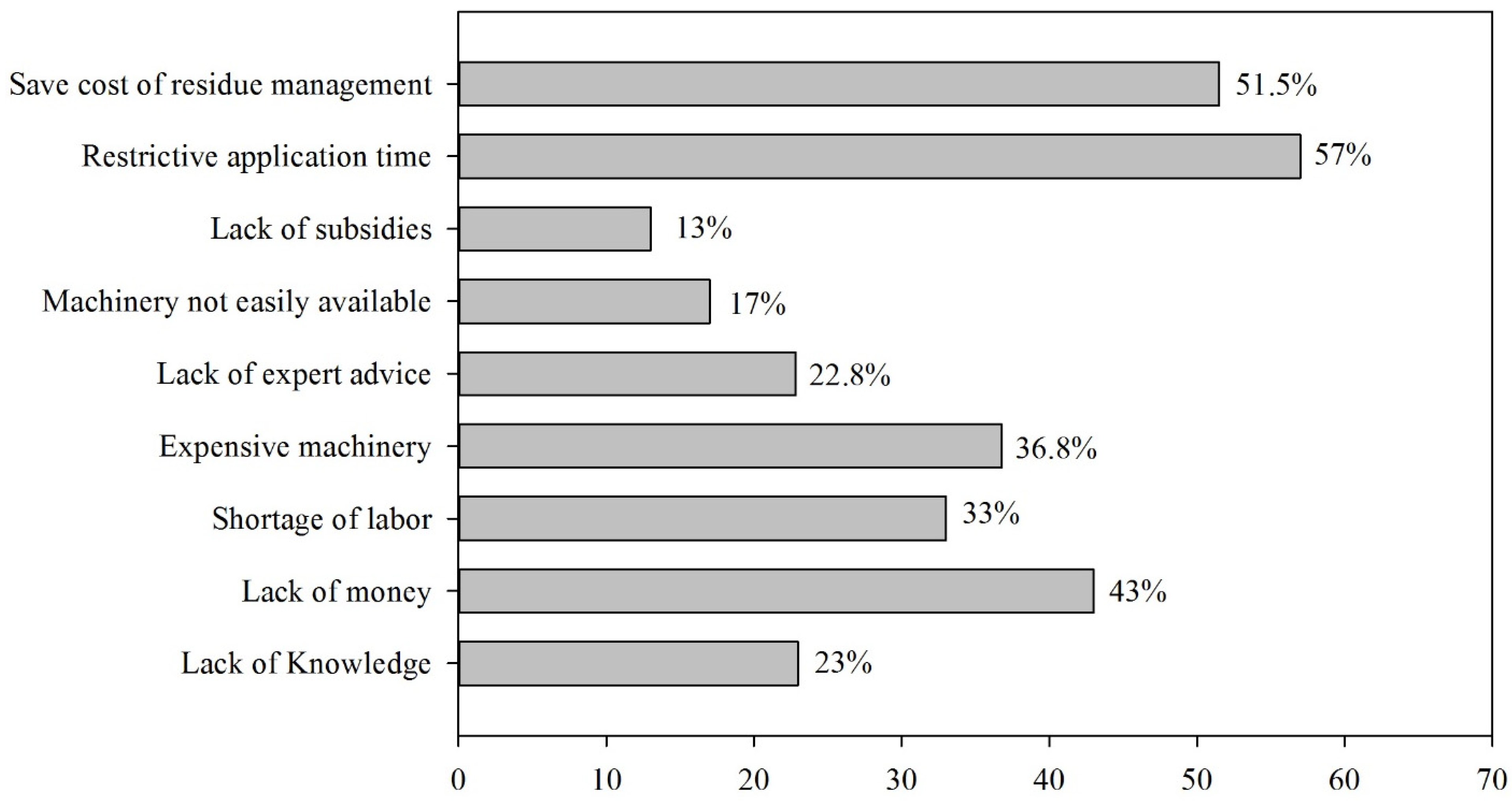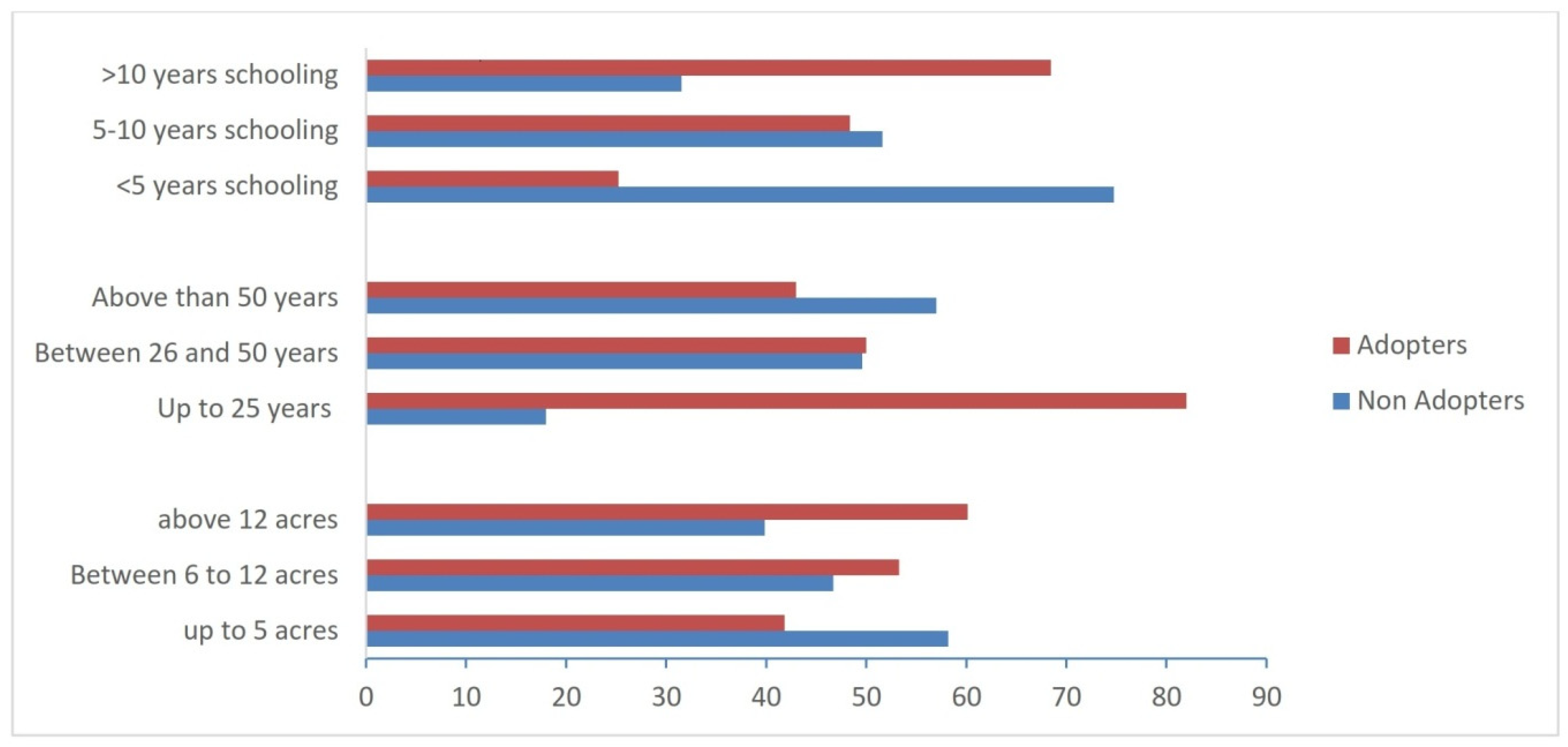1. Introduction
Economic development and rapid population growth have put intense pressure on the agriculture sector to fulfill rising industrial and food demands [
1,
2,
3]. As a result, intensive agriculture with high use of inputs and the introduction of modern technologies has developed rapidly in recent decades [
4,
5,
6]. The use of synthetic fertilizers and pesticides, as well as the extension of cultivated land, exploitation of natural resources, and burning of crop residues to clear fields for preparations of the new crops have all resulted in a slew of environmental issues [
7,
8,
9,
10], including water contamination, air quality impairment, the emission of greenhouse gases (GHG) and soil degradation [
11,
12,
13]. These problems are not only impairing environmental sustainability but also pose a severe threat to human health.
Increasing greenhouse gas emissions due to rapid industrialization and urbanization in developing countries have contributed to the changing climate [
14]. Furthermore, crop residue burning has proven to be a non-point source of greenhouse gas emissions in many agrarian economies, including Pakistan [
12,
15]. Over the past few decades, Pakistan’s agriculture sector has been under tremendous pressure to meet the food needs of a population of more than 220 million, rising at rate of nearly 2% each year [
16]. This immense pressure has led to the intensification of agriculture and multiple cropping across the country. The current cropping intensity (159%) also shows intense competition between different crops due to the harvesting and sowing seasons overlapping.
Consequently, farmers often engaged in unsustainable practices such as burning crop residues to clear fields for the following crop [
17,
18]. In recent years, massive crop residue burning has resulted in air quality deterioration, smog, haze, heat waves, and different health issues [
19,
20,
21,
22]. In severe circumstances, it has led to an emergency situation with several deaths, thousands of hospital admissions, temporary closure of airports, highways, and schools [
22,
23,
24,
25], as well as significant economic losses [
26,
27].
Given the growing adverse impacts of crop residue burning, adopting sustainable and environmentally friendly residue management practices is required to safeguard the environment and people’s health [
28,
29,
30]. Numerous studies have reported several environmentally friendly crop residue management practices [
31,
32,
33] that provide additional economic benefits through generating income and reducing healthcare expenses. However, the adoption rate is quite low, even though the positive impacts of sustainable crop residue management practices (SCRMPs) are widely studied, understood, and implementable at the local level [
34,
35,
36,
37]. The low adoption rate may be due to a lack of information about the benefits of such strategies, particularly their environmental and health implications.
Limited research on the positive aspects of SCRMPs could be another reason for its low adoption at the farm level. Few studies have documented crop residue burning, focusing on the negative impacts or the expense of managing crop residues at the farm level [
38,
39]. For instance, Riaz and Hamid (2018) [
22] highlighted that crop residue burning is now restricted to a few places in Punjab province, but if it continues, it will spread across all the plain areas of Pakistan. Mendoza (2015) [
40] also suggested that recycling crop residues in the landscape of the Philippines would be an excellent approach to reducing the country’s reliance on imported fertilizers while simultaneously helping to combat climate change. Moreover, little research has been conducted on exploring the nexuses between the positive aspects of adopting SCRMPs and their impact on human health [
41,
42]. Therefore, further research is needed to explore the benefits of SCRMPs and the underlying factors and constraints that prevail at the local level.
Given the aforementioned research gap, this study will provide better insight into farmers’ adoption of SCRMPs and their impact on human health. Precisely, this paper addresses four important research questions: First, how do farmers respond to SCRMPs? Second, how does the adoption of SCRMPs differ among farmers? Third, what factors sway farmers’ decisions to implement SCRMPs? Fourth, what impact does the adoption of SCRMPs have on human health costs?
3. Results and Discussions
3.1. Descriptive Statistics
The results of descriptive statistics are shown in
Table 1. According to these, 51% of farmers do not burn crop residues after harvesting and instead use sustainable crop residue management practices. The results revealed that almost half of the respondents are aged between 30 and 50 years. Additionally, around 30% were 50 years old. Those farmers aged 30 years old accounted for 22% of the total sample. Likewise, half of the farmers have less than 20 years farming experience. Education wise, almost half of the respondents only received a primary education, whereas only 20% of the respondents have an elementary or high school level education. The majority of the farmers are small landholders and have land up to 4 acres. More than 32% of farmers have a farm size of between 5 and 12 acres. The farmers cultivating the land of more than 12 acres were considered to be large farmers. Around 30% of farmers have an annual income that is less than 250,000 Pak Rupees (PKR), while 33.8% earn between PKR 250,000 and 50,0000, and 43.3% earn more than PKR 500,000 and above. The results also show that farmers do not have enough income or wealth to access the necessary equipment to adopt sustainable crop waste management practices. Farmers in study areas have limited access to farm machinery. Only 24.5% of the farmers have access to tractor trollies and other farm implements such as disc ploughs, rotavators, and threshers. This study’s results align with those of [
64,
65], which revealed that farmers had higher ages, lower education levels, and limited availability of resources in developing countries. Further, limited access to farm machinery and tool may be an essential determinant of the non-adoption of sustainable crop residue management.
3.2. Health Impacts and Health Costs of Crop Residue Burning
It is acknowledged that significant crop residue burning can negatively affect local communities [
66]. However, to explore these negative health impacts and associated costs, we asked households to recall what kind of health issues they or their family face during the burning of crop residues season. The significant adverse health impacts reported by farm households include coughing (45%), eye irritation (33%), headache (31%), nausea (29%), skin irritation (23%), and respiratory allergies (22%) (
Table 2). Blurred vision, bronchial infection, dizziness, asthma, and fatigue are other minor side effects. Respiratory allergies are directly connected with air pollution. Further, the severity of the disease also depends on temperatures and the dispersion of plumes from burning. These results are consistent with previous reports and studies that have found a variety of negative consequences for households due to crop residue burning [
67,
68,
69]. Cheng et al. (2011), [
70] also found that agricultural crop residue burning contributes to adverse health effects in indoor and outdoor environments, such as cardiac and respiratory morbidity and mortality. Moreover, 7350–16,200 premature deaths and 6.0 million asthma attacks/year were reported in Delhi due to increased emissions from crop residue burning in the north-western part of India [
71].
Further, we found that the intensity of negative impacts varies across study districts depending upon the intensity of crop residue burning. For instance, most households in Gujranwala, where rice burning is a huge problem, reported more negative impacts than other districts. Gujranwala is one of the leading cities in rice production due to easy access to water resources. Resultantly, more residual is produced. Due to ease, farmers burn the crop residue to get rid of it, contributing highly to GHG emissions. Therefore, Gujranwala is an environmental vulnerability city in Punjab district, Pakistan. Crop burning activity has been increased due to the lack of storage facilities, and market opportunities also drive the farmers to burn crop residues [
72].
Table 3 demonstrates the perception of the respondents regarding crop residue burning intensity and its impact on health.
Further, we also explored other indirect or non-health-related impacts of crop residue burning (
Table 4). Many respondents reported that crop residue burning directly affects their work productivity as they fall ill due to heavy smoke at the workplace. Furthermore, many farmers claimed that the smoke generated by burning caused smog and caused accidents on major highways. Farmers in Gujranwala and Rahim Yar Khan, in particular, have noticed this phenomenon. Crop residue burning has resulted in the deaths of some people in serious situations, either as a result of accidents or health problems.
3.3. Health Cost Due to Crop Residue Burning
Further, we estimated the economic value of health damages caused due to crop residue burning. In chronic cases, exposure to a high level of air pollution may cause permanent health injuries such as the development of lung diseases such as asthma, Chronic Obstructive Pulmonary Disease (COPD), bronchitis, lung capacity loss, and emphysema, cancer, etc. [
71]. For this purpose, we acquired information about the number of visits to the hospital or clinic for each case and asked for information on different aspects of each visit, including the cost of medication, traveling/transportation, self-treatment, and preventive measures (
Table 5). In the end, we calculated the total health cost for each health impact. The present study estimates health costs due to burning crop residue among households. The results revealed that the total medication cost on average for chronic diseases is USD 13.37, and for non-chronic illnesses, USD 8.79. The cost of preventive measures is very low among the farmers.
Moreover, farmers rely on self-treatment, which deteriorates the efforts to curb the burning of residues. The medication cost and traveling are also a cause of the increase in the expenses. Especially, the availability and access to specialized health facilities are not enough in Punjab’s rural areas. People also use domestic methods, which are also very cheap. However, adopting preventive measures during burning days is also not very common. Farmers are responsible for making management decisions that will optimize crop yields and minimize environmental impacts.
3.4. Farm Level Adoption of SCRMPs
We assessed actual adoption in the study districts to evaluate farmers’ current understanding of sustainable residue management practices and the farm-level adaptation mechanism. According to the findings, farmers in three research districts used various methods to treat crop residue (
Figure 4). The decomposition of crop residues has both positive and negative impacts on crop production. Therefore, the farmer should adopt practices that have a maximum positive effect on the environment and minimum negative effect on human health and the environment. For example, soil management with crop residues covers a wide range of aspects, such as residue decomposition, soil erosion control, nutrient recycling and availability to plants, and various conservation practices related to tillage for maximizing crop yields. So, if accurate knowledge about sustainable adoption of crop management practices provides to farmers, they are willing to adopt SCRMPs. It is well known that the sustainable management of crop resides can efficiently improve the soil chemical properties, such as pH, electrical conductivity, cation exchange capacity (CEC), and the transformation of different primary and secondary plant nutrients. So, there is need to provide this important information to farmers.
The use of crop residue as livestock feed was the key sustainable crop residue strategy adopted by more than half of the farmers. The results imply that feed crop residual to livestock does not break the cycle of nutrient and biomass return to the soil since these can be returned in manure, which improves soil fertility. Therefore, sustainable livestock feed is necessary for optimal use of crop residue. Other measures include on-farm use, residue retention, and bio-fertilization. In the study area, most farmers are smallholders and often rear livestock to manage their livelihood. Therefore, they often use crop residue as a source of animal feed. For this purpose, they collect and store residue in one place. Mostly, farmers keep residue in the open field due to the non-availability of a warehouse or appropriate storage place.
Further, farmers often use crop residue for bedding and shelter for their livestock. It is done mainly in winter to give comfort to milking animals. Farmers reported that this practice has resulted in a positive impact on the quality and quantity of milk. Furthermore, some farmers in the study districts use the residue retention technique. Farmers in Gujranwala, for example, have implemented a residue retention policy to use crop residues to enhance soil and water quality. This strategy would be beneficial in terms of agronomical and economically. These factors would lead to significant advantages (i.e., reducing costs of fertilizers and water). Makkar (2016) [
73] explored that using crop residue for livestock feed would help to improve the three traditional sustainability pillars (economic, environmental and social). Similarly, [
74,
75,
76] also reported that adopting the residue retention technique and conservation agriculture improves soil health nutrients ratio and increases water conservation in the field.
In addition to positively impacting sustainable residue management practices, the adoption rate is still very low due to various constraints, even though sustainable crop residual management improves the fertility and productivity of the soil. We further explored farmers’ key hurdles and limitations restricting them from adopting sustainable crop residue management practices. According to the study findings, the saving cost of residue management, restrictive application time, limited knowledge, lack of training in advanced technologies, and limited financial capacity are critical reasons for low adoption (
Figure 5). Many other studies, e.g., [
76,
77], have also identified the current policies, financial constraints, etc., low education level restricts farmers from adopting these practices. So results imply that landholding should increase to achieve the optimal benefits from sustainable crop residue management. Small landholding farmers should have proper access to credit and fertilizer facilities. Education and lack of proper training are the main barriers to optimal crop residue use.
We also examined how crop residue management practices were adopted by different farmers based on their level of education, age, and landholding scale (see
Figure 6). Farmers were classified into three groups based on their level of education: (1) farmers who are illiterate or have had less than 5 years of schooling; (2) farmers who have had 5 to 10 years of schooling; and (3) farmers who have had more than 10 years of schooling. Farmers were also classified into three age groups: (1) those under the age of 25, (2) those between the ages of 26 and 50, and (3) those over 50. Farmers were classified into three groups based on the size of their farms: (1) small-scale farmers with up to 5 acres of land, (2) medium-scale farmers with 6 to 12 acres of land, and (3) large-scale farmers with more than 12 acres of land.
The results in
Figure 6 show a positive association of adoption decisions with education level. About 68% of the farmers with higher education do not burn their crop residues and use sustainable residue management practices. Of the farmers with 5–10 years of education, only 48% adopted other practices. Similar positive associations of this behavior with education level were reported by [
74,
78]. Furthermore,
Figure 6 revealed that farmers with a higher education adopted these practices than less educated farmers. Likewise, the adoption rate among the young farmers is also high compared to the old farmers. These findings are consistent with the findings of [
78,
79,
80], who found a positive relationship between education level and sustainable crop residue use. The proportion of adoption among young and middle-aged farmers is around 82–50% compared to old-age farmers. The share of farmers with landholding up to 5 acres is 42%, but the large-scale farmer’s rate was almost 60%. These findings indicate that large-scale farmers were less constrained in implementing residue management practices. These findings are consistent with previous research, e.g., [
78,
80], which found a connection between landholding and the adoption of sustainable residue management practices.
3.5. Knowledge, Understanding, and Sustainable Residue Management Activities
In the next step, we explored the level of awareness and knowledge about the hazardous impact of crop residue burning among adopters and non-adopters. We found that the level of knowledge and awareness was higher in the case of adopters as compared to non-adopters. This implies that awareness about negative impacts plays an important role in deciding between the adoption of crop residue practices. Furthermore, we discovered that farmers who were aware of various alternative or beneficial aspects of sustainable crop residue management practices were more likely to follow them.
Knowledge of the hazardous impact of burning crop residue on health was explored. Further, we asked about the households who suffered any illness because of the residue burning. We categorized the farmers into two categories, those who do not burn the crop residues are the adopters, and the others are non-adopters. Mostly, non-adopters know that burning cause hazardous health impact. Likewise, burning also induced illness among households during the harvesting season (
Table 6). The number of adopters is higher than non-adopters. This result implies the lack of information about damages associated with crop residue burning. Most adopters know about sustainable crop reside management, such as livestock feed, reside used as a shelter for livestock, etc., so they optimally use it rather than burning it. The results can also be related to their financial condition. They are holding small land, so the residue produced is used for livestock to avoid the extra cost of feeding their livestock.
3.6. Empirical Results
3.6.1. Empirical Results of the Propensity Score Matching
To estimate propensity scores, logistic regression is used to regress the likelihood of implementing residue management activities against a variety of covariates.
Table 7 displays the effects of the propensity score estimate.
We analyzed the farm-level adaptation measures across different categories of farmers, i.e., the farm size and their educational level. The farm size of adapters also positively impacts farmers’ adaptation for residual crop management. The results are consistent with those of [
81,
82]. Education has been identified as an important component of implementing sustainable agricultural residue management strategies [
83,
84]. The results imply that an increase in education increases the likelihood of implementing sustainable crop residue management practices. Educated farmers adapted more compared to less educated farmers. These results are consistent with other research findings, confirming that the number of years of schooling plays a vital role in pushing humans to make economically sustainable and environmentally health-conscious decisions [
85,
86].
We found inconclusive results regarding the relationship between age and the adoption of new practices among farmers. The variable for the farm household’s age, on the other hand, is negatively but insignificantly correlated with adoption decisions. This finding may be attributed to the predicted opposite impact of age on the likelihood of implementing management activities that operate across the decision-networks maker’s and planning horizon [
77,
87]. The results may imply that people with a higher age bracket are less indulged in adoption practices. Similarly, income has no significant impact on farmers’ decisions to follow sustainable crop residue management practices.
Tube well ownership does significantly affect the farmer’s decision to adopt sustainable residue management practices. This is true because the easy availability of water at farms makes farmers flexible in making decisions on harvesting and sowing crops. This flexibility also allows them to manage harvest and crop residue effectively and easily.
The rotavator ownership reduces the probability of adoption, possibly reflecting that those households used this instrument for commercial purposes and less need to use it for their purpose. Further, variables related to farm machinery and implements such as tractor trollies and disc ploughs are significantly related to the adoption decision, implying that farmers having easy access to farm machinery can easily adjust their sowing and harvesting timing, allowing them to manage their crop residues in a better way.
Furthermore, having a tractor trolley is a key component in using agricultural residue responsibly, as farmers sometimes have difficulty transferring their residue to other locations. As a result of the lack of adequate transportation or cost of the transportation, they may be influenced to burn crop residue as a convenient and cost-effective technique. The results are in line with other study, e.g., [
64].
The results imply that access to extension services and canal water information may positively impact the farmers’ adaptation decision. Access to extension services and canal water information has positive coefficients and tends to expedite anti-burning sustainable management practices. These findings proved our assumption before the analysis and aligned with the other studies’ results, e.g., [
72,
88].
In the case of residue management activities, however, the negative coefficient of the weather forecasting variable indicates that farmers could not relate their decision behavior to the weather situation. This result also depicts the poor weather forecast facilities available to the farmer. This region is not rich in technological innovations; therefore, farmers cannot adopt residual management practices. The results also imply that most of the adapters use weather forecasting information from different sources to adjust management options, which may not be accurate due to differences in weather conditions in these three regions. Each region has different weather conditions, negatively impacting overall crop residual management. These findings are not consistent with the results of other studies, e.g., [
81,
87,
89].
The results for regional dummies are partially consistent with a previous study [
51,
90,
91]. Furthermore, the negative coefficients for regional dummies imply that farmers in both districts (Gujranwala and Faisalabad) were less likely to adapt residual waste management practices than the Rahim Yar Khan district farmers. This may be because farmers in Rahim Yar Khan are more concerned with health and the environment or do not have any awareness/knowledge about the adverse effects of residual burning.
3.6.2. Impact of Sustainable Crop Residue Management Practices on Health Costs
It is understood that adopting sustainable crop residue management practices may generally reduce health costs in the areas where farmers do not burn crop residues. We calculated the casual impact of adopting sustainable residue management practices on health costs to test this hypothesis. For this purpose, first propensity scores were calculated using logistic regression. After calculating the propensity scores based on identical propensity scores, the nearest neighbor matching approach was used to align adopters (treatment group) and non-adopters (control group). The nearest neighboring method (NNM) discarded non-adopters during the matching process, resulting in a substantial reduction in the total sample size from 420 to 214 for post-matching effect analysis.
The post-matching results are presented in
Table 8, which reveals that the adoption of sustainable crop residue management practices significantly reduces the health cost. Here, the ATE shows the Average Treatment Effect (ATE) for all without matching and correcting the biases. In contrast, ATT shows the average treatment effect for treated, i.e., the impact after matching and correcting the biases. The results showed that the overall impact of sustainable crop residue management practices (ATE) without correcting biases was more (PKR 897) than the impact calculated after correcting the biases. The value of ATT (PKR 312) shows that adopting sustainable crop residue management practices will reduce the health cost by PKR 312 per season.
Further, the results of sensitivity analysis presented in
Table 9 also confirm the adequacy of our results. The results show a decline in R-square value, F-value, and mean standard differences, indicating reduced biases. Overall, more than 55% of business has been reduced through the matching process. The impact of health costs is only determined by the adoption of sustainable crop residue management practices.
4. Conclusions
Agricultural crop residue burning has emerged as an essential challenge in the agricultural production system because of rising air pollution episodes, the release of short-lived climate pollutants, and declining soil health. Crop residual burning negatively affects the health and environment of rural livelihoods in Pakistan adversely. Thus, timely adaptation is desirable to reduce potential losses at the farm level. This case study analyzed farmers from rural Pakistan and provided insights into their adaptation to residual management determinants. This study reveals the extent to which farmers perceive residue as a problem and adapt their residual management practices accordingly.
The results of our study revealed that adopting sustainable crop residue management is considered the best alternative to prevent the burning’s hazardous impact on the ecosystem. However, farmers end up with higher costs in terms of medication expenses due to facing health issues because of the burning. Likewise, a loss of working hours and medication costs are significant contributors to the losses.
The cost reduction shows the effective approach to tackle the expenses. Moreover, results also revealed that adopting sustainable crop residue management practices helped reduce the expenses due to health issues. This study also confirms that sustainable utilization of crop residues can improve households’ health status and help reduce the financial burden. Overall, this study proved and reckons that the sustainable utilization of crop residue is beneficial in curbing the hazardous impact of residue burning on the environment. However, farmers are still not well aware of these benefits due to the numerous constraints.
This implies that large-scale awareness campaigns in both rural and urban areas should be created. Government agencies’ positions are crucial to this campaign’s success. Focus group awareness, workshops, and community mobilization activities are highly feasible choices. Similarly, capacity building of extension workers and local stakeholders could also help enhance the sustainable management of crop residues. Research institutes, government agencies, non-governmental organizations (NGOs), and the private sector can significantly remove these constraints through the vibrant collaboration for capacity building and dissemination of innovative practices among farmers.
Furthermore, policies should be updated based on on-the-ground research and small farmers, who account for more than two-thirds of Pakistan’s total farmer population. Both of these measures will help to alleviate the negative effects of climate change and can aid farmers in improving their well-being and ensuring better health. In addition, they will help to minimize the negative impacts of crop residue burning. In this regard, the interventions from the circular bioeconomy involve the recirculation of material flows and the adoption of the restoration cycle.
This study used cross sectional data to explore the nexuses between the positive aspects of adopting SCRMPs and their impact on human health. Nevertheless, there are numerous limitations worth mentioning. First, this study concerns the elicitation responses related to health impacts and burning instead of scientific data. Secondly, research is necessary for improvements and was validated with satellite-based fire count data. Furthermore, it can be extended by estimating the GHGs emission load due to crop residue burning activity over said regions during the burning months to assess its impact on health. It also helps to widen the scope of the study and make it more comprehensive that encompassing the problem well.
